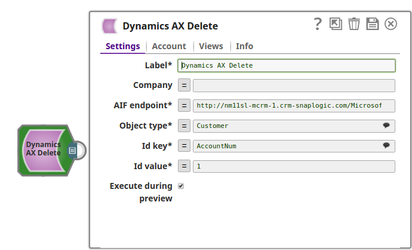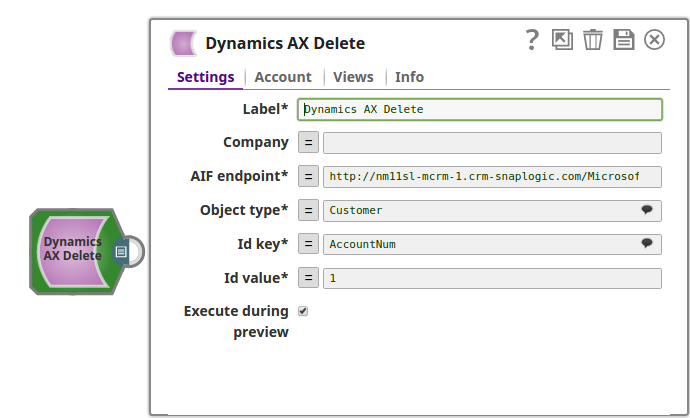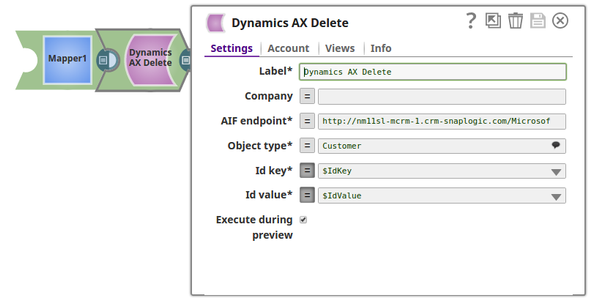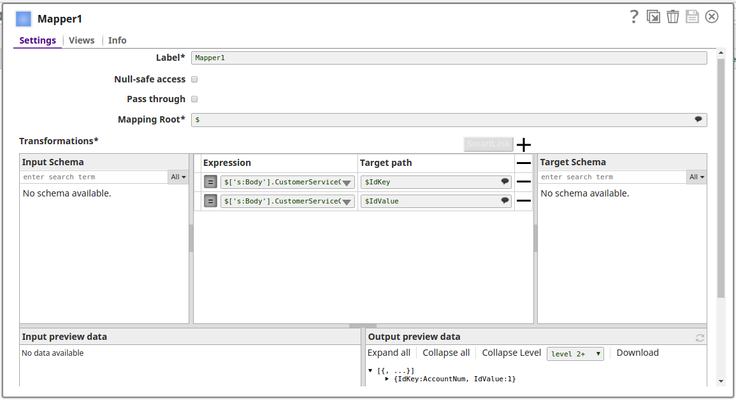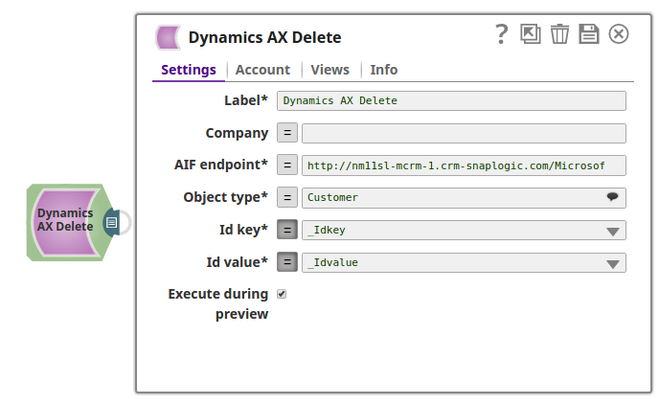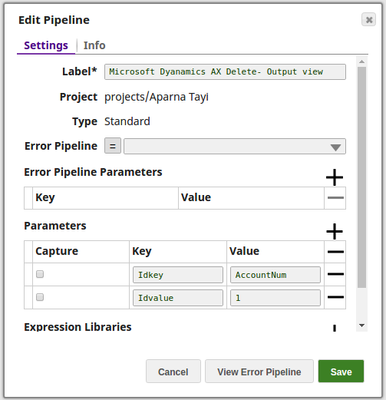Microsoft Dynamics AX Delete [Deprecated]
On this Page
| Snap Type: | Write | ||||||
|---|---|---|---|---|---|---|---|
| Description: | This Snap deletes records from the Dynamics AX instance according to a specific ID key and ID value. ETL Transformations & Data FlowThis Snap enables the following ETL operations and flows: The Snap collects target Dynamics AX instance information from user input or pipeline parameters. The Snap gets the ID Key and ID Value from user input, pipeline parameters or the upstream Document. It uses this data to send a SOAP request to the corresponding AIF inbound port on the Dynamics AX instance. The SOAP response from the server is passed to the downstream Snaps. Input & Output
Modes
| ||||||
| Prerequisites: | 1. Microsoft Dynamics AX 2012 instance 2. An enhanced integration inbound port on the AX instance that has one or more delete operations setup | ||||||
| Limitations and Known Issues: | NA | ||||||
| Configurations: | Account & AccessThis Snap uses account references created on the Accounts page of SnapLogic Manager to handle access to this endpoint. See Microsoft Dynamics AX Account for information on setting up this type of account. Views
| ||||||
| Troubleshooting: | |||||||
Settings | |||||||
Label | Required. The name for the Snap. | ||||||
| Company | The company name on which to perform the delete operation. The company should be defined on the AX instance side. The property can be provided through user input or pipeline parameters. | ||||||
| AIF endpoint | Required. URI of the inbound port. You may find the information at the Dynamics AX instance: System administration > Setup > Services and Application Integration Framework > Inbound ports > [Your port name] > URI. The property can be provided through user input or pipeline parameters. | ||||||
| Object type | Required. The object type on which to perform the delete operation. The value of the property depends on the object types contained in the target inbound port. The property can be provided through user input or pipeline parameters. Example: Customer | ||||||
| Id key | Required. The field name of the record's ID. The field names are different among different object types. It reflects the EntityKey.field in the AIF request. See: https://msdn.microsoft.com/en-us/library/aa638403(v=ax.10).aspx The Id Key property is suggestible and:
The property can be provided through user input or pipeline parameters. Example: AccountNum | ||||||
| Id value | Required. The ID value of the record that is to be deleted. It reflects the EntityKey.value in the AIF request. See: https://msdn.microsoft.com/en-us/library/aa638403(v=ax.10).aspx The property can be provided through user input or pipeline parameters. | ||||||
Basic Use case
The following pipeline describes how the Snap functions as a standalone Snap in a pipeline:
Successful execution of the pipeline displays the preview output shown below:
Typical Configuration
The key configuration of the Snap lies in how you pass statements to delete the Dynamics AX records. As it applies in SnapLogic, you can pass the statements in the following manner:
- Without Expression: Directly passing the required values in the Dynamics AX Delete Snap.
With Expressions
- Query from an upstream Snap: Mapper Snap passing the required statements to the Dynamics AX Delete Snap:
- Pipeline Parameter: Pipeline parameter set to pass the required statements to the Dynamics AX Delete Snap:
Advanced Use Case
The following describes a pipeline with a broader business logic involving multiple ETL transformations. It shows how, in an enterprise environment, Create, Read, Search and Delete functionalities can typically be used. The pipeline download link is below.
This pipeline moves records from a Salesforce instance to the Dynamics AX instance, where the records are created, searched and read for the required IDs and deleted as needed.
The ETL Transformations:
- Extract: The Salesforce Read Snap retrieves the records from an object type from the Salesforce instance.
- Transform: The Mapper Snap maps the records from the Salesforce object to the Dynamics AX instance.
- Load:The Dynamics AX Create Snap creates the records on the AX instance.
The pipeline further uses:
- The Mapper Snap maps the records to be searched from an Object type.
- The Dynamics AX Search Snap searches all the records.
- The JSON Splitter Snap splits the the records based upon the field names.
- The Dynamics AX Read Snap reads the records based on the given fields and they are retrieved from the bottom using the Tail Snap.
- The Mapper Snap maps the records to be deleted using the Dynamics AX Delete Snap.
Downloads
Important steps to successfully reuse Pipelines
- Download and import the pipeline into the SnapLogic application.
- Configure Snap accounts as applicable.
- Provide pipeline parameters as applicable.
Snap Pack History
Have feedback? Email documentation@snaplogic.com | Ask a question in the SnapLogic Community
© 2017-2025 SnapLogic, Inc.
